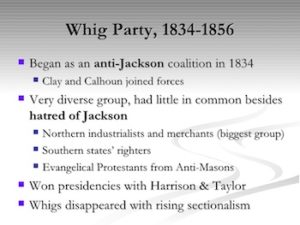
*On this election day in 1834, we celebrate the beginning of the Whig Party in the United States. This was a political party active in the middle of the 19th century.
Alongside the Democratic Party, it was one of the two major parties during the late 1830s, the 1840s, and the early 1850s, part of the period some scholars describe as the Second Party System. Four U.S. presidents were affiliated with the Whig party for at least part of their respective terms. Other influential party leaders include Henry Clay, Daniel Webster, William Seward, John J. Crittenden, and Truman Smith.
The Whigs emerged in the 1830s in opposition to President Andrew Jackson, pulling together former members of the National Republican Party, the Anti-Masonic Party, and disaffected Democrats. The Whigs had some links to the defunct Federalist Party. Still, the Whig Party was not a direct successor to that party, and many Whig leaders, including Clay, had aligned with the rival Democratic-Republican Party. In the 1836 presidential election, four Whig candidates received electoral votes, but the party failed to defeat Jackson's chosen successor, Martin Van Buren. Whig nominee William Henry Harrison unseated Van Buren in the 1840 presidential election but died one month into his term.
Harrison's successor, John Tyler, was expelled from the party in 1841 after clashing with Clay and other Whig Party leaders over economic policies such as re-establishing a national bank. Clay won his party's nomination in the 1844 presidential election but was defeated by Democrat James K. Polk, who presided over the Mexican American War. Whig nominee Zachary Taylor won the 1848 presidential election, but Taylor died in 1850 and was succeeded by Millard Fillmore. Fillmore, Clay, Daniel Webster, and Democrat Stephen A. Douglas led the passage of the Compromise of 1850, which helped to defuse sectional tensions in the aftermath of the Mexican American War. Nonetheless, the Whigs suffered a decisive defeat in the 1852 presidential election partly due to sectional divisions within the party.
The Whigs collapsed following the passage of the Kansas–Nebraska Act in 1854, with most Northern Whigs eventually joining the anti-slavery Republican Party and most Southern Whigs joining the nativist American Party and later the Constitutional Union Party. The last vestiges of the Whig Party faded away after the American Civil War, but Whig ideas remained influential for decades. The Whigs favored an interventionist economic program (the American System) which called for a protective tariff, federal subsidies for the infrastructure, and support for a national bank.
The party also advocated modernization, meritocracy, the rule of law, protections against majority tyranny, and vigilance against executive tyranny. The Whig base of support was centered among entrepreneurs, planters, reformers, Protestants, and the emerging urban middle class, but it had little backing from farmers or unskilled workers. The party was active in the Northern and Southern United States and did not take a strong stance on slavery; Northern Whigs tended to be less supportive of that institution than their Democratic counterparts.